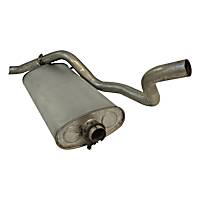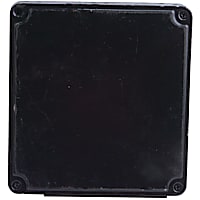Note: Please check your local and state laws regarding exemptions and coverage of car emissions testing in your area.
Emissions testing, also known as a smog check, is required in many parts of the country. The procedure helps ensure your vehicle meets the emissions standards set by the Environmental Protection Agency (EPA) and/or state governments. Exactly how often your vehicle must be tested depends on the requirements set by the state or local government. The same goes for which model year is exempt or subject to emissions testing.

There are two basic types of emissions tests: tailpipe and onboard diagnostics (OBD II). Which one your car must undergo depends on the requirements in your area, as well as the age of your vehicle.
With an OBD test, a scan tool is plugged into the vehicle’s diagnostic port. That allows the smemissog technician to communicate with the onboard computer to ensure it isn’t flagging any emissions-related problems. OBD tests are only performed on model year 1996 and newer vehicles.
A tailpipe test, on the other hand, requires inserting an exhaust gas analyzer into the car’s tailpipe. The analyzer measures the levels of hydrocarbons (HC) and carbon monoxide (CO), both of which are pollutants, as well as harmless carbon dioxide (CO2) and oxygen.
Many locations also check levels of the pollutant oxides of nitrogen (NOx).
It’s also worth noting that, in many cases, a visual inspection is part of the emissions test (both tailpipe and OBD). During the inspection, the technician checks to be sure the car’s emissions equipment is intact. Additional items, such as the gas cap, may be inspected as well.
Tips & Tricks for Passing an Emissions Test
The requirements for passing a tailpipe test are different from those for passing an OBD test. Therefore, each has a distinct set of preventative measures you should take before test day.
Passing a tailpipe test
If a tailpipe test is required where you live, there are a few steps you can take to ensure a favorable outcome. While these measures won’t guarantee your car will pass, they will give you a leg up on test day.
Warm up your engine
Before getting your car tested, drive for at least 20 minutes to warm it up. You should also schedule an appointment with the testing center so that you can be accommodated while your engine is still warm. Doing so will help ensure both the engine and catalytic converter are at the optimum temperature for testing.
Make sure your car is up-to-date on routine service
Following the manufacturer’s recommended maintenance schedule helps keep your vehicle running at its best. The schedule includes procedures such as fluid changes, filter replacements, and tune-ups—all of which can affect the results of an emissions test.
So, before you visit the emissions station, be sure your car is up-to-date on routine service. An outline of the service schedule is located in your owner’s manual.

Fix any known engine-related problems
If your engine is running rough, stalling, or exhibiting any other problems, you’ll want to get the issues fixed before getting an emissions test. The reason being, engine-related problems often lead to an increase in tailpipe emissions.
Make sure the “Check Engine” light is off
Your car will not pass an emissions test with an illuminated check engine light. If the light is on, you’ll need to get the problem that triggered it fixed prior to testing.
Bring your vehicle to a smog test location that retests for free
Having to put your vehicle through another round of emission testing means more expenses. It’s best to go to a shop that offers retesting for free just in case your vehicle doesn’t pass on your first try.

Passing an OBD test
You’re in luck if your location only requires an OBD test. There are just a couple of things you’ll need to check before heading to the emissions station.
Make sure the “Check Engine” light is off
Once again, your car will not pass an emissions test if your “Check Engine” light is illuminated. Make sure to address this issue and resolve the problem that triggered before you go in for testing.
Ensure all the monitors have run
Your car’s computer runs self-tests known as “monitors” on emissions-related systems. During an emissions test, a smog technician will check that all (or nearly all, depending on local requirements) of these monitors have “run” successfully.
The monitors are reset whenever the battery is disconnected. Clearing diagnostic trouble codes (DTCs) from the computer’s memory also resets the monitors. If either has been done to your car recently, you’ll want to be sure the monitors have run before emissions testing. If they have not, your car will be given a “not ready” test result, rather than passing or failing.
You can check whether the monitors have run using a scan tool or code reader, if you have one. Otherwise, you’ll want to drive the vehicle at various speeds (both on city streets and the highway) for an extended period of time. That way, you’ll have a better chance of being ready for emissions.
How long does a smog check take?
A smog check typically takes more or less 30 minutes. This can vary depending on the number of vehicles in line and whether or not you were able to schedule your vehicle for an appointment ahead of time.
What causes a failed emissions test?

There are countless reasons why your car could fail an emissions test. To know the root cause of the problem, a professional diagnosis is required. Here are some examples of what a technician might find during troubleshooting:
Engine and transmission problems
Problems with either the engine or transmission can lead to an increase in tailpipe emissions, as well as an illuminated “Check Engine” light. The end result is a failed emissions test.
Emissions equipment failure
Modern cars have an array of emissions equipment onboard. A few examples include the catalytic converter, exhaust gas recirculation system, and evaporative emissions system. Problems with such equipment can easily cause your car to fail an emissions test.
Module and sensor issues
Today’s vehicles contain an expansive collection of computers (referred to as modules) and sensors. Issues with these electronics, their wiring or data network, can lead to a failed emissions test.
Air/fuel delivery problems
Your car’s engine needs a precise mixture of both air and fuel to run properly. If either of these ingredients is thrown out of whack, there’s a good chance your car will fail its emissions test.
Ignition system concerns
The ignition system contains the components that work together to ignite the air/fuel mixture inside the engine. A problem with any of these parts can create an engine misfire that leads to a failed emissions test.
If you cannot afford the necessary emissions-related repairs, some states offer financial assistance to help out. Check with your state or local government to find out what’s available in your area.
Get Emissions Parts Online
It’s important to keep your car’s muffler and tailpipe in good condition for its emissions test. However, these parts wear out and might fail prematurely. It’s a good thing you can easily find high-grade replacement mufflers and tailpipes at CarParts.com.
At CarParts.com, we make it easy for you to find the muffler and tailpipe that meets your needs and fits your budget without sacrificing quality. Plug your car’s details into our website’s vehicle selector, and you’ll find the most suitable products in our extensive catalog. Ordering a new muffler and tailpipe takes only several taps on the screen of your mobile device, and we ship to your doorstep. You can also get your order in as little as two (2) business days if you live in the continental US and place your order before noon ET.
For competitively priced mufflers and tailpipes that you can rely on, make CarParts.com your only stop. View our selection of mufflers and tailpipes and get the most bang for your buck when you order one today.
Products Mentioned in this Guide
Any information provided on this Website is for informational purposes only and is not intended to replace consultation with a professional mechanic. The accuracy and timeliness of the information may change from the time of publication.


 Muffler & Tailpipe
Muffler & Tailpipe
 Engine Control Module
Engine Control Module





























Raw fuel smell coming into cab